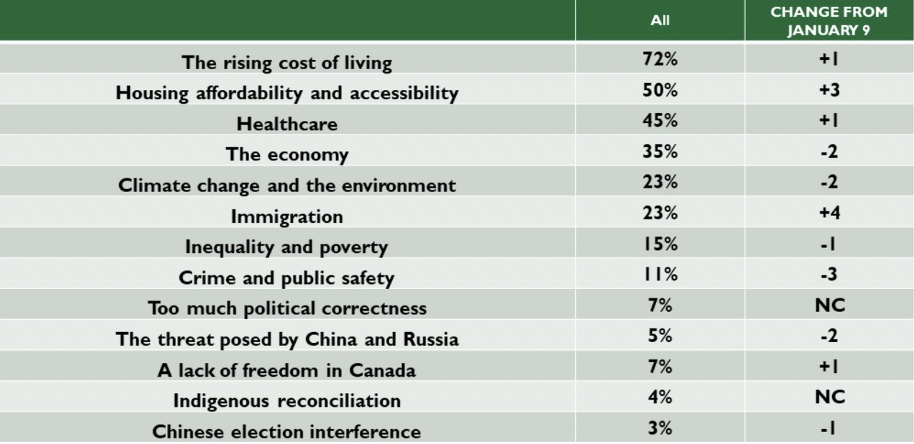Climate Change Isn’t an Election Issue, It’s an Era
 LSF
LSF
By Dan Woynillowicz
February 21, 2024
“Every election is a climate election.”
Far from being just a slogan, this refrain reflects the reality that society’s reckoning with climate change is destined to span not just successive election cycles, but multiple decades. Still, political and policy leadership will continue to dictate the level of effort (or lack thereof) made to pivot away from burning fossil fuels, aggressively reduce carbon pollution, and avert the worst possible outcomes of climate change.
But what if we consider climate change as not just another election issue, but as one that cuts across all other issues? What if, as futurist Alex Steffen does, we acknowledged that “Climate change is not an issue but an era”?
To compartmentalize climate change as an environmental issue misrepresents the scope and scale of how it is already impacting — and will increasingly impact — most facets of our human existence. Indeed, in some cases, the very solutions that will help us combat climate change can also serve to address or alleviate other issues.
But beyond the next election outcome’s implications for these efforts, there’s also a question about the role that climate change might have in shaping the outcome itself. Currently, pundit prognostication suggests that climate change, as an issue, won’t have much bearing on the next federal election. Recent public opinion research backstops this view.
Polling by Abacus Data exploring the top three most important issues facing Canada today found the rising cost of living as the most cited, identified by 72% of respondents. Housing affordability and accessibility (50%), healthcare (45%) and the economy (35%) followed. Tied for fifth were climate change and immigration, identified by 23% of respondents.
Figure 1: Abacus Data poll findings — The Three Most Important Issues Facing Canada Today?
Carbon tax, cost of living and the transition to clean energy
Let’s start with the rising cost of living, given how dominant it is as an issue of public concern.
While opponents of the carbon tax have made great hay out of blaming it for increasing the price of everything, analysis by University of Calgary economists Trevor Tombe and Jennifer Winter lays this claim to rest. “While concern around affordability is clearly warranted,” they write, “climate policies are not a significant driver of the rising cost of living. Nor will removing policies such as carbon pricing materially improve the situation.” Highlighting the impact on grocery prices in BC, as an example, Tombe and Winter find that “the latest estimates from Statistics Canada suggest carbon taxes increased the average cost of food by about 0.33% relative to what it would be in the absence of carbon taxes. That’s the entire effect.” That’s 33 cents on a $100 grocery bill. Not nothing, but not the smoking gun carbon tax detractors would have people believe.
If governments are going to tackle affordability, they need to focus on the things that are actually making life less affordable. Exploring the drivers of post-pandemic inflation in Canada through its peak in 2022, Dr. Tombe and another University of Calgary colleague, Yu Chen, found (Figure 2) that when Canadian inflation peaked at 8.1% in June 2022, higher energy prices were responsible for nearly one-third of inflation, at 2.6% points (with 1.9% points from gasoline alone). Those energy costs, of course, were shaped by global prices for oil and natural gas, both of which were rising thanks to a robust post-pandemic economic recovery and lagging oil production in key OPEC countries before being turbocharged by Russia’s invasion of Ukraine.
Figure 2: Key Drivers of Consumer Price Inflation in Canada, Jan 2017 to Nov 2022
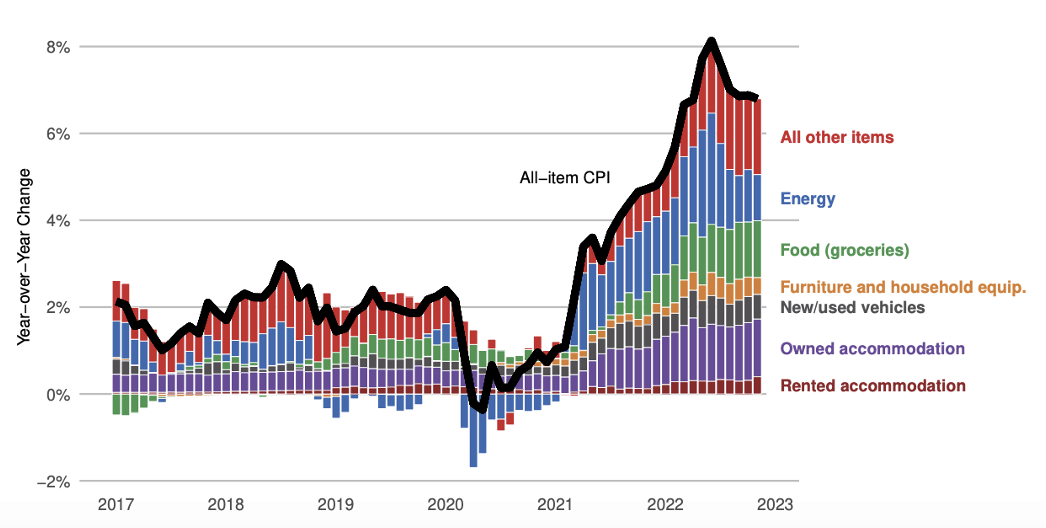
They also looked beyond the direct effect of energy prices to estimate spillover effects, noting that “Energy, after all, is an important input in the production of many goods and services throughout the economy. Products that are transportation intensive or that require heating or cooling — food, for example, satisfies both these conditions — may be particularly sensitive to energy price increases.” Here again, the findings are significant: items sensitive to oil prices accounted for nearly 60% of Canada’s non-energy inflation in July 2022, and over 85% of the increase since February 2020 (Figure 3).
Figure 3: Contribution of Items Sensitive to Oil Prices to Non-Energy CPI Inflation
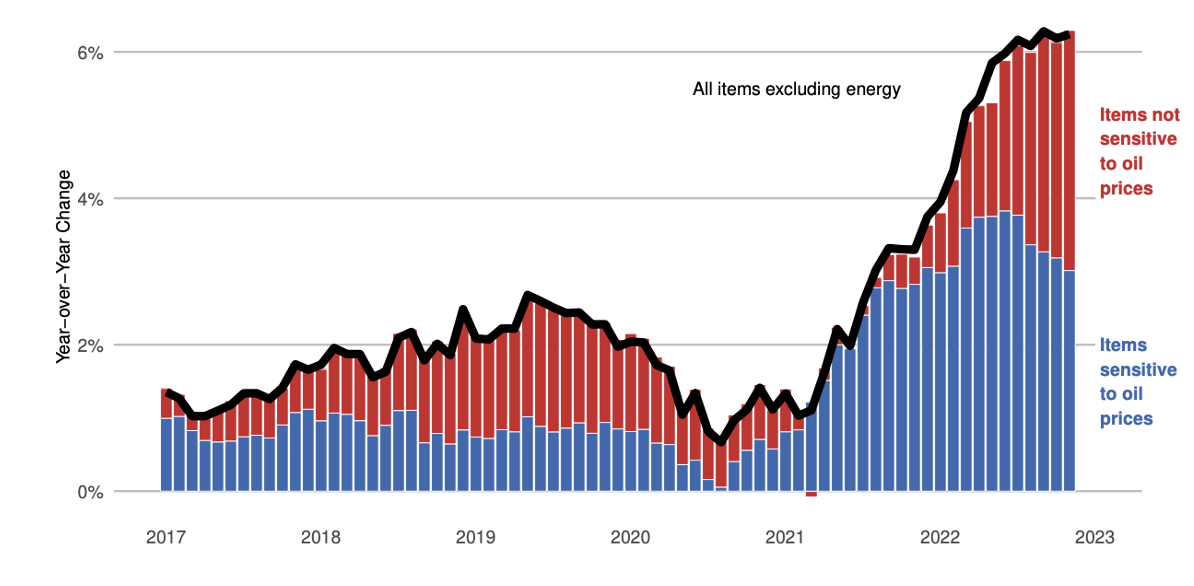
In sum: “High energy prices, and the resulting production-cost increases for many other goods and services throughout the economy, may largely explain Canada’s accelerating inflation.”
This shines a spotlight on a key benefit of the transition from fossil fuels to clean energy —escaping the volatility and price spikes that bedevil global oil and natural gas prices. As researchers from the Roosevelt Institute have noted, based on their research, it’s clear that transitioning from fossil fuels towards renewables can help stabilize energy prices for two reasons: “First, renewable energy will bring the majority of energy consumption into the electricity sector, a highly regulated sector that has historically produced stable energy prices. Second, renewables prices are inherently stable compared with fossil fuels.”
While critical mineral inputs and supply chain snags can affect the capital cost of wind turbines or solar photovoltaic (PV) panels, the reality is once these technologies are installed the cost is fixed. Unlike a coal or gas plant, their fuel — the wind and sun — is free. And the more we plug into a clean power grid — to fuel electric vehicles and meet heating and cooling needs with heat pumps — the more we can reduce reliance on oil and gas and minimize exposure to their price fluctuations. As an Oxford study concluded, “Compared to continuing with a fossil fuel-based system, a rapid green energy transition will likely result in overall net savings of many trillions of dollars — even without accounting for climate damages or co-benefits of climate policy.”
Climate considerations in housing affordability and health care
What about housing affordability and climate change? While the linkages to climate change may not seem quite as clearcut, there are numerous intersections and how policymakers tackle this issue has the potential to increase, lock-in, or reduce carbon pollution and homeowner costs.
A lack of affordable housing in cities encourages urban sprawl, forcing households into the suburbs and exurbs, which are typically underserved by public transit, meaning more driving (and the resulting fuel bills and emissions). Meanwhile, more frequent and intense extreme weather events — made more likely by climate change — can further fuel the need to build (or rebuild) housing, driving up costs, while also making house insurance more limited and more expensive.
As the Affordability Action Council has noted, “Every residential building that is built between now and 2050 without the net-zero target in mind will create a liability down the line that someone will have to pay for. While retrofits generate multiple benefits, it is much cheaper to build new housing that meets a net-zero standard than it is to retrofit buildings.” Which is why they recommend a multi-faceted approach to new housing that focuses on affordability as well as convenience, resilience and energy efficiency, with energy costs and net-zero climate goals in mind.
While some politicians may position climate action and housing affordability as a trade-off, polling by Abacus Data found that 62% of Canadians believe that it is important to address the housing affordability issue without compromising Canada’s climate goals. Similarly, 78% believe it’s important to build housing in ways that minimize pollution contributing to climate change, and 84% believe it’s important to develop new housing in a manner that is resilient to climate change impacts. The linkages between climate change and housing affordability are clear, as are Canadians’ expectations.
Health, health care and climate change similarly overlap. A recent Health Canada report explored — in great detail — the myriad health impacts of climate change resulting from rising temperatures and extreme heat, wildfires, and the expansion of zoonotic diseases into Canada, while also highlighting how these are not just future concerns, but impacts already being experienced today. As a resident of BC, I am still struck by the impacts of the climate change-fuelled heat dome and catastrophic flooding in the province in 2021, in which 600 people lost their lives and many more suffered.
The Canadian Climate Institute has similarly documented how the health impacts of climate change will have a knock-on cost to Canada’s health care system in the billions of dollars, while also reducing economic activity by tens of billions of dollars over the coming decades.
Clearly, measures that make our communities more resilient to a changing climate —whether that be to extreme weather, fire or floods — and that reduce air pollution will help address the health impacts on Canadians and costs to our already-struggling health care system.
It’s the Economy, Stupid
Last, but certainly not least, is the economy. While there is still considerable attention paid to the potential economic implications for Canada’s oil and gas sector from aggressive climate action, global markets are quickly re-orienting towards the economic opportunities of the energy transition. What if that’s the lens through which federal parties’ economic platforms are considered in the next election?
According to BloombergNEF, 2023 saw record-breaking investment in the energy transition (Figure 4). Nearly US$1.8 trillion of capital flowed into the global clean energy transition, up 17% relative to 2022 and more than three times more than in 2019. In Canada, the installed capacity of wind, solar and energy storage grew by 11.2% in 2023, reaching a new total of 21.9 GW, according to data compiled by the Canadian Renewable Energy Association. Perhaps ironically, 92% of that growth occurred in Alberta, as the provincial government’s moratorium on renewable energy approvals didn’t impact already-approved projects from coming online.
Figure 4: Global Investment in Energy Transition, by Sector
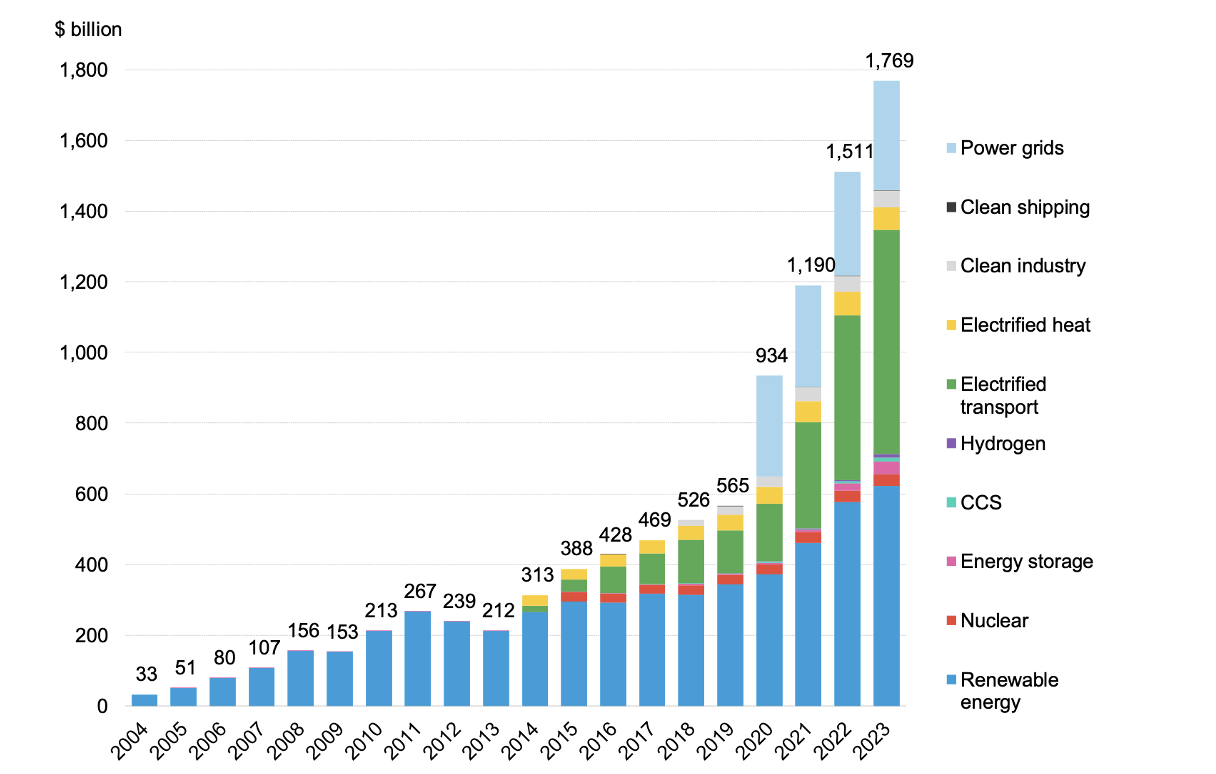
Note: Start years differ by sector but all sectors are present from 2020 onwards. Most notably, nuclear figures start in 2015 and power grids in 2020. CCS refers to carbon capture and storage.
But the energy transition sector that has featured most significantly in Canada is electrified transport and the battery supply chain. Over the past couple of years hardly a month has gone by without a significant investment in Canada’s battery and electric vehicle manufacturing and supply chain — including Volkswagen, Stellantis, Ford, General Motors, Umicore, LG Energy Solutions, Posco Future M Co Ltd and more. It’s notable that almost all of these investment decisions referenced Canada’s clean electricity supply as a key factor in their decision to invest here.
An analysis by the Future of Canada’s Automotive Labourforce (FOCAL) initiative found that in a scenario with widespread consumer acceptance of EVs and continued efforts to secure additional EV production mandates, Canada’s automotive manufacturing industry would see a significant increase in its assembly capacity to over 1.7 million vehicles by 2040. With growth in the battery supply chain — and critical mineral production and processing to supply it — the analysis found that that more jobs would be created in assembly, battery production, and mining than would be lost in internal combustion engine and powertrain production, with a net economic gain over $50 billion and close to 100,000 jobs created.
The success to date in attracting investments is the result of federal, provincial and municipal collaboration. Together, their efforts have led to Canada leapfrogging China to secure the top spot in BloombergNEF’s global lithium-ion battery supply chain ranking, which looks at each country’s potential to build a secure, reliable and sustainable supply chain for lithium-ion batteries . According to BloombergNEF, Canada’s consistent manufacturing and production advances, strong ESG credentials, policy commitment at both the provincial and federal level and integration with the US automotive sector (which is benefiting from the US Inflation Reduction Act), have helped us become a leader in forming the battery supply chains of the future (Figure 5).
Figure 5: BloombergNEF’s Global Lithium-ion Battery Supply Chain Ranking
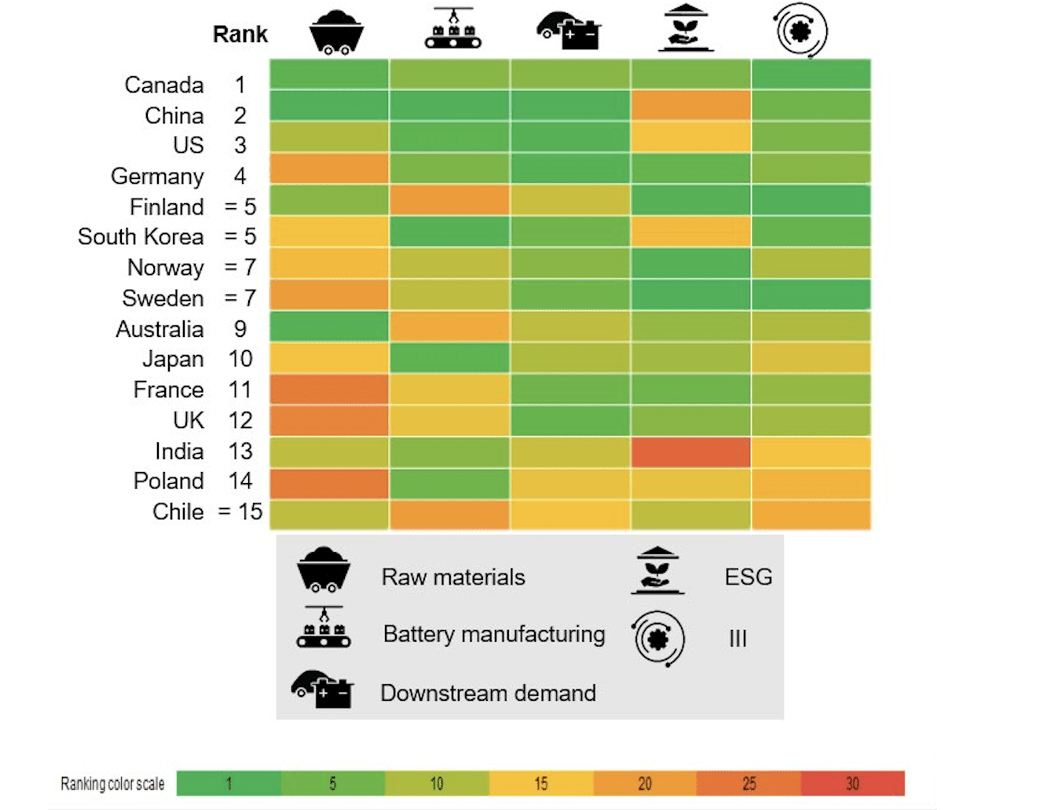
This success didn’t happen by accident, nor is future success assured. Durable government policy (and not just dollars) is critical, a message that leaders of all political parties, federal and provincial, need to consider. As BloombergNEF noted, “The rankings reflect only developments in 2023, and that actions by other countries in this competitive market – or future inaction on the part of Canada – could result in upsets in the years ahead. Across all the metrics, it’s a race where in a year where you decided to do nothing, other people bypass you.””
As I’ve previously said, “The risk to Canada, then, is that we continue to pay short shrift to the opportunities at hand—in critical minerals, batteries and other technologies, and clean and renewable electricity — in favour of trying to prop up the viability of our oil and gas sector. That we focus on the sunset, rather than the sunrise.”
The stakes in the next federal election
Canadians deserve political discourse grounded in the reality that it is neither too late or too futile to act, but that we are not progressing quickly enough. While it’s easy to be cynical about efforts to date, especially as the direct impacts of climate change arrive at our doorstep with greater frequency and ferocity, analysis of the federal government’s 2030 Emissions Reduction Plan by the independent Canadian Climate Institute (Figure 6) concluded that current and proposed policies can deliver 85 to 90 per cent of Canada’s 2030 target.
Figure 6: Canadian Climate Institute Modeling of Canada’s Emissions Pathway
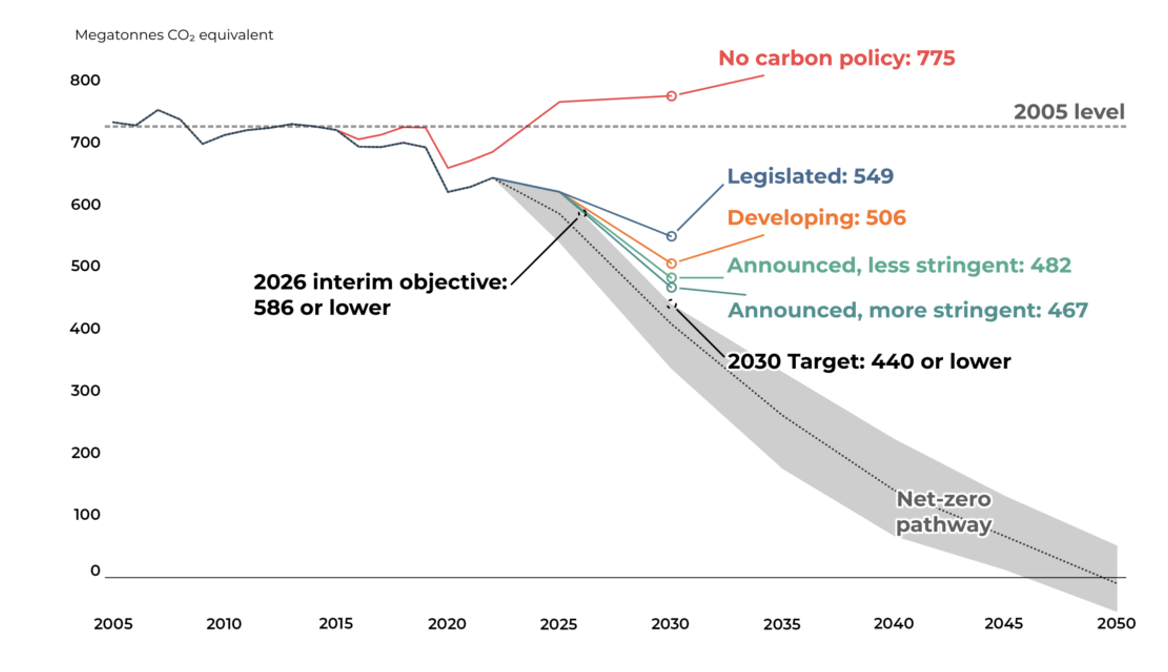
In fact, the whole world has made significant strides forward. As David Wallace-Wells has documented, “Thanks to astonishing declines in the price of renewables, a truly global political mobilization, a clearer picture of the energy future and serious policy focus from world leaders, we have cut expected warming almost in half in just five years.”
This isn’t to suggest we are making progress quickly enough, or even that the success of current policies and approaches is guaranteed. If we are to lock-in progress to date and build on it, it’s clear that we will need ongoing and enhanced policy leadership. With the 2020s unfolding as the “decisive decade” for climate action the bottom line is quite simple:
Policy matters. Politics matters. And every election matters.
In Canada, the 2015, 2019 and 2021 federal elections were all — in hindsight if not evidently at the time — climate elections. In both the 2019 and 2021 elections, climate change was the top election issue, according to polling by Angus Reid.
Floods, wildfires, hurricanes and other extreme weather events to come may yet bump climate change, as an issue, up voters’ priority list. But as documented above, efforts to avoid the worst outcomes of a changing climate aren’t just about the environment. The impacts of climate change cut across top of mind issues from affordability, to housing and healthcare, as do the solutions.
While some politicians might prefer a “carbon tax election,” for obvious reasons, such a narrow consideration of climate change would do a disservice to Canadians. Whether affordability, housing or health care are their ballot box concern, the spectre of a changing climate — and how we confront the challenges and seize the opportunities of that change — needs to be discussed and debated.
It’s time for federal politicians — of all political stripes — to approach climate change for what it is: not an issue, but an era.
Contributing Writer Dan Woynillowicz is the Principal of Polaris Strategy + Insight, a public policy consulting firm focused on climate change and the energy transition.

